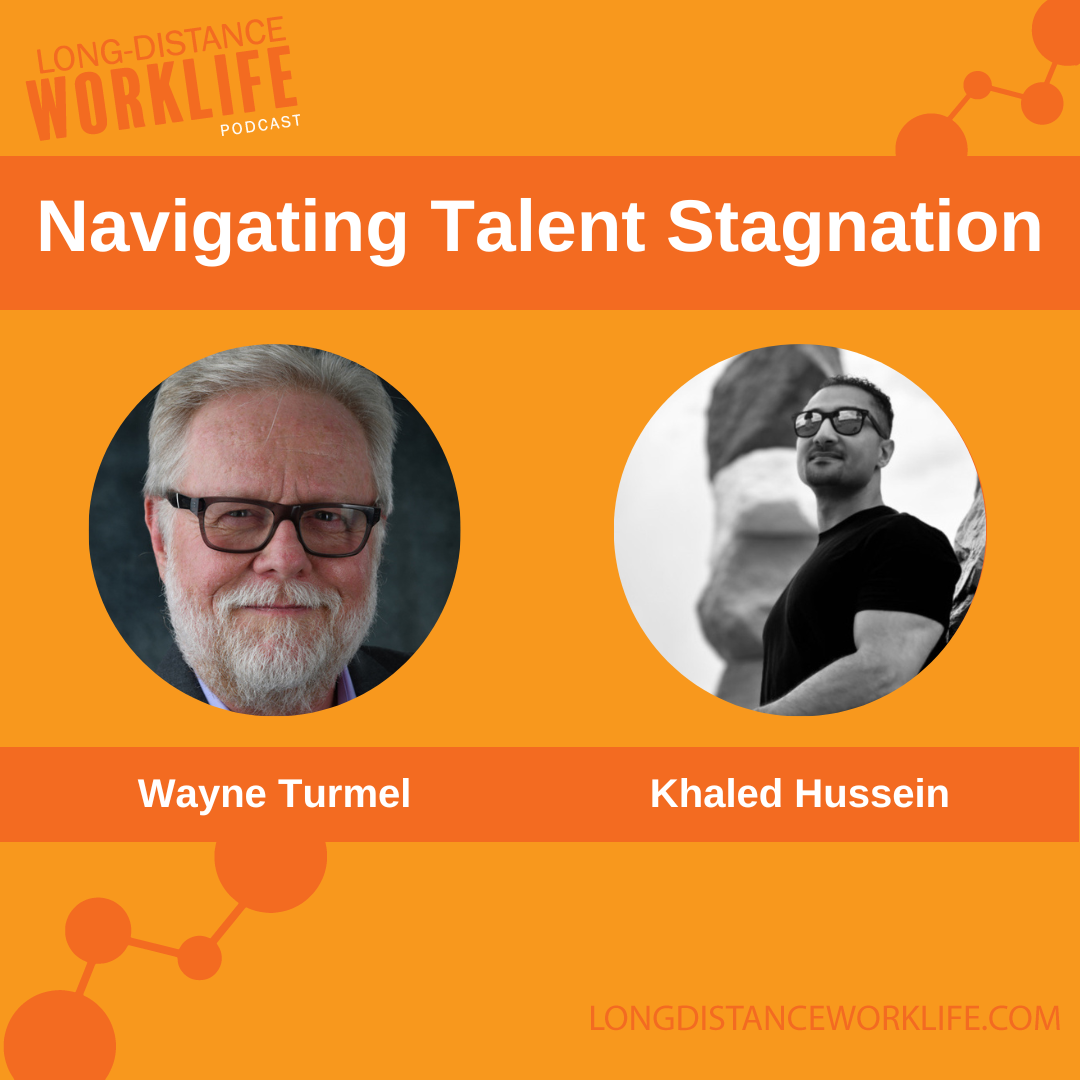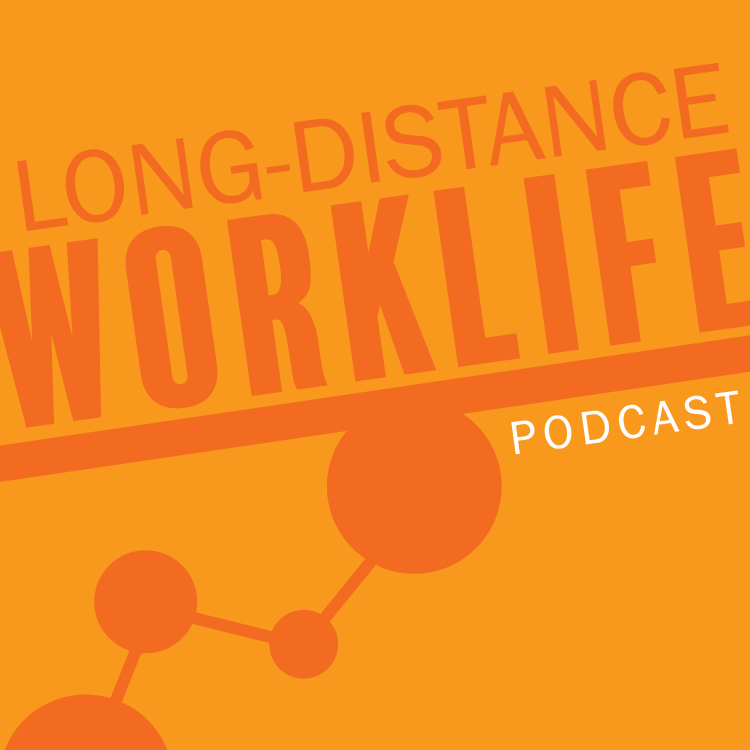Abhinav Chugh from Peoplebox joins Wayne to answer the question, "Why do people resist using technology designed to make managing easier?"
Peoplebox is an OKR & Performance Management Platform that help you solve for alignment, team performance and engagement to drive exceptional business outcomes.
Additional Resources
Free Video Series!
Join us for a powerful, 4-part video series titled, Demystifying Remote Leadership. You will learn how to create solid working relationships in a virtual team with more confidence and less stress!
Transcript
Wayne Turmel: Everybody. Welcome, welcome once again to the Long-Distance Worklife podcast. I am your humble servant, Wayne Turmel. This is the podcast where we look at remote work, technology, leadership and just surviving, thriving, keeping the weasels at bay in this crazy world of remote work and all the changes associated with it. This is one of our Marisa-free episodes not that that makes it better, just different because I am talking to a longtime colleague of mine, somebody I've known for a while, and I think it's high time we had this conversation.
So I am being joined by Abhi Chugh, who you should be able to see on the screen. There he is. And we are talking about the metrics that managers need to follow and how do we do that and how does software play a role and why does that freak people out? So that's what we're going to be chatting about.
Joining us from Bangalore, Abhi, my friend, how are you?
Abhinav Chugh: I'm great. Thank you for having me.
Wayne: Thank you for being had. So very quickly, tell the folks what Peoplebox does.
Abhi: Thank you. So what our vision is to build an operating system of strategy, execution for high growth companies. And that sounds like a very complicated setting. So I'll make it very simple a lot of time in companies, and especially as remote heads of companies, people, different departments are very misaligned, you know, are not really sure what are their strategic priorities, what our key goals.
So just imagine a central system in the company. Any company is going pretty fast or and in that central system, all your strategic priorities, all your cross-functional goals, all your initiatives are aligned tracked and achieved. And that is a system we are trying to create or we have build, which helps companies execute their strategy faster and get get better business results.
Wayne: Now, that, of course, sounds fabulous. Like all technology sounds fabulous because you're building it to solve a problem. And Lord knows misalignment is a problem as you roll it out in companies, especially remote first and hybrid companies, what are the misalignments? What are people missing out on that they need the help with?
Abhi: I think I think it's a great question and a lot of times people don't understand what exactly is misalignment. People think that a misalignment is all about a lot of leadership or the employees not knowing what our number one goal is. And I don't think that's true because a goal is usually a number. It could be a revenue, it could be a user margin.
It is generally a number and leaders make sure that they communicate that number so frequently that everybody knows you want to achieve hundred million dollars in revenue. We want to achieve 3.5% margin or we want to be on a team of 50 million monthly active users. That's very easy. I think the misalignment happens when people don't know what our focus is.
So if you and this is what I always to say to the founders that are top leadership in the middle of the night and ask them What are our top three priorities for this quarter? And see how they answer it and how misaligned they are, a lot of times you can come back and say, What are our leaders?
Our founders are misaligned, all while our one of our co-founders said this and we said this. So a lot of misalignment happens on what our focus or strategic priorities is and what is actually made. It really was is the whole pandemic and the remote one because no longer now employees are in the same room, they're working from home and misaligned is now more visible.
Wayne: And yeah, I think there's a couple of things that have happened. And you point out the pandemic. It's kind of the the watershed moment, right? There was the before times and now there's now there's now in the before times you had misalignment across teams, across functions. But I think with remote work, people become very focused on their nuclear team and rightly so.
Right. We're trying to get the team through this and stay in communication. But the cross-pollination with other departments and other teams doesn't happen the way it did when you had to look at each other in the cafeteria.
Abhi: Absolutely. Absolutely. And I think that the the place where we come in, which is to build that central system where across the line goals are tracked, it fragmented. I would say two things which change this. I mean, imagine maybe five or ten years ago and think of any company like that the bold tracking happens in silos. Every department has their own maybe a spreadsheet or a dashboard on a PPV and usually more where you can't find or go to a place where you see how stated goals are aligned with the product goals.
Our design goals are aligned, but it just doesn't happen now. Four things really changed. This one was this whole introduction to the framework of OKRs. You know, primarily invented by, of course, Andy Grove and Intel, but made famous by John Deere and Google. And then you see all these amazing hypergrowth startups like Spotify, Twitter, LinkedIn, adopting it, you know, and startups are usually at the forefront of adopting it because again, for them, execution is everything they have, everything right.
Wayne: OK, so for for the uninitiated, let's not we try on this show not to go down the jargon road. OKR stands for.
Abhi: OKRs are goals framework stands for objective and key result. So it's, it's, it's drastically different from the traditional goals like KPIs, which is key performance indicators or PR which is key results area. What ours make sure is that your goals also have strategy in it. So to give you an example that suppose you are a company who are at stage $10 million revenue and you want to in the next one year or two $20.5 million.
So you will put your number one company goals at $25 million revenue from current $10 million that's a typical KPI. OK got it what. OK and goes and says no that's not a great goal. The reason why that's not a great goal is because that doesn't answer the question how, how are you going to do that? What is it that you want to focus on which will help you achieve?
So primarily breaks the ball into two different pieces. One is the objective where do you want to go and what are your focus on strategy? Around it? So, you know, that could be like become the the most customer centric company in India or become the fastest stay CRM system. So it is your strategy, which is underline it could be anything for Amazon.
It's customer service for Google, it's innovation. What what they actually highlight is the focus OK? And that's make it really different. And then the result is just the number. How do you measure it? How do you know that you are going to go and achieve that? So again, it is it's a very famous very one of the fastest growing sort of framework.
Almost every company now from start ups to the Nike's and the IBMs and the, you know, cap Gemini of the world are adopting it. And that's what I see. So that was the sort of the first step towards building this growth aligned goal system. OK, but so.
Wayne: We're going to start I'm going to stop you there because that's fine at a high level. We're talking about strategies now we need to take it down to the managers.
Abhi: Yes. Yes.
Wayne: And so the company has goals and strategies and we've got stuff in place and now it's dropped in my lap as the manager. What I know that people box has the structure and the the ways of putting all this in, but it's always what problem are you trying to solve? Right. So what are managers and teams not doing?
They get in the way of executing that. Absolutely. And aligning it.
Abhi: I think you ask a really good question. What is the problem you're trying to solve? And ultimately, when you look at either the managers or the the leadership or the business heads that are going to try to solve what we call the class, the results and the retention, which is everybody is aligned from an employee to his or her manager to he's our manager to each other of the leadership.
They all want this do we want faster results? They want better retention. OK, well, when it comes to managers, you know, what are the challenges that they face in achieving better results? And retention? And the number one challenge that they face themselves is misalignment, all the employees aligned or our fear about how their work is aligned for the overall company purpose.
Are they all working towards what are the companies number one, focus on Friday, you know, and having that clarity is very important. When we run engagement surveys, one of the very important questions we ask is how happy are you working at the company or how motivated are you working under the manager they're a very high level question. But when you dig deep on why they are unhappy working with the company, the number one thing comes is the work God.
If they are not really clear about their role, they're not really clear about their job description. They're not really clear that they're really amazed by the company vision, what the company is doing, but they're not really clear that how the work, the day to day tasks that I am doing, how's that blind to the word confusion and that problem is solved.
If somehow you can build a system which makes sure that any employee, even an intelligent company, is able to align his or her work all the way to the company's strategic priorities or their overall mission. And that's the challenge we try to solve, and that helps manage it to a great level because that makes sure that we are all going in the same direction that the work doesn't happen in silos.
There's no chaos. And we all you know, while you are collaborating or while we are, you know, working in a unit, actually, we all are working towards the same people.
Wayne: So it makes perfect sense on some level. If, you know, I'm struggling to do this on my own, it makes sense that there is a structure and there are steps and procedures to help me do that. And and whenever a company puts in a tool like this, I have seen it time and time and time again. That everybody agrees this is a problem.
Everybody agrees that this would solve it, and they immediately fight the technology they immediately resist having to follow the procedures, even though what was happening before wasn't working. There is just something about codifying and making this that much of a process that seems to make people crazy. What has been people's experience? Not just with PeopleSoft, but you've been in this business a long time.
Why do you think there is that resistance and how does an organization overcome it? If they want people to use the darn thing?
Abhi: I think that's a wonderful question. And I agree with you that the one of the biggest challenge in software, and especially in software, would change if it's bring some sort of a change management is a huge resistance. And I think the only way to go and solve that resistance, if you understand that where that resistance coming from. And I just think our example, you want to build a system where all your cross functional goals which means your marketing, your company goals, your initiatives by the product and engineering that all at once.
OK now what does that mean? Does that mean that if I'm an engineer who is working in say to like JIRA or if I'm a sales guy who's working in a CRM system like a sales for the HubSpot are we going to double entries? I have to go in a built in Salesforce and then I have to go and do it in incentive system that just bad.
I mean, I would myself resist that because you are just increasing my job. Oh, and one of the major challenges happens when some of these software systems create more or heads and more work for the people, you know, just to solve a certain problem. And that has been our experience that if you ask people to do some things so that it solves a larger problem, you are sitting on a failure.
And what we try to do there is to make technology. Your friend and not the fool any more and say that is the best way to go and solve that problem is through some magically easy tracking of goals to deep integration. What that means is that imagine that you are a sales guy and you use sales force and you go and enter everything you know, all your ideas, all your leads or all your theories into the sales for the moment.
You do that through the integration, through an invisible software. The central system is automatically updated. That's a really, really welcome move because now I don't have to go and double one. And in fact, when I present to my leadership, I don't have to call people, so I don't download. I don't have to export something and pasted in a PDF or a spreadsheet.
I already have already made data available for me. So but the answer to this adoption or the resistance challenge is to how do you make it so magically easy for people to do their work and reduce the time? I give a very good example. Let's just take a simple example of business use in companies. Almost every company they go through this monthly business reviews on a quarterly business review, and that generally happens on PowerPoints, you know, parties and theme starts creating the people.
It is two weeks ago they have to put the narrative they have to put again, they have to go to different tools, take the screenshot, copy pasted, and many of the time when they present the data, it's obsolete. It's like one record, OK, and a lot of effort goes out. Intention is that how can we make this new or happen within hours and make the data really light?
So it sounds both the problem. It's not the leadership problem, but the data is naive and it tells the employees and the business heads or the managers problems that they don't have to work. And that's our way of solving and overcoming these challenges.
Wayne: So certainly having to stop the redundancy in the multiple thing, I mean, even even having multiple passwords to remember is enough to make people crazy.
So let's as as we get to the end of our chat here, talk to me about the two or three main behave was that if there was a system, obviously they should use minimal box, but assuming that they have some other system or there's something in place, what are the two or three behaviors that managers can change or perform that will help with alignment that maybe they aren't doing now?
Abhi: Yeah, I think I think the first thing that we have learned, and it's a very top down thing, I think I think managers have to have a certain constraint there because if from the leadership they don't have a way to align their cross-functional goals, there is very little managers can do. You know, if I'm a sales head and there is no way I can go and align my goals with the product team or with the design team or with the operation team, there is very little my sales manager or the product manager can do about it.
Wayne: And it's very natural and it's very natural then to control what you can control. Right. And the team becomes more insular and more nuclear.
Abhi: So so one of the things that we try and do is to go to the leadership or go to the business heads and say that OK, this is this this needs to start from you. When you set your goal to that are quarterly goals or semiannual goals and you've got to set it in a more aligned and collaborative and that results will be magical.
And then look at all the companies who have adopted opioids or any on any cross align frameworks. But once that happens, then it is so magically for the managers because now they have the visibility that just wasn't. I give a very simple example that is a problem in every company so salespeople in every company are dependent, acutely dependent on product.
They want a certain features because their customers or their leaders are asking. But they have no way to view what is the status of that particular feature. So you pick an example, let's suppose you are of your sales person in a software company and all your want to be customers are hot leads are asking for, say, Microsoft integration.
So you call a product manager and say, Hey, we need that environment. You say, OK, we already have it in the roadmap well, there's no way for you to know what is the status of that because that project is being run in Dev Toolset JIRA or Microsoft Azure, which as a sales guy I don't have access to, you know, so the only option now I have is to keep calling the manager, keep calling the engineers and say, Hey, what's the status?
And if for some reason, if this is delayed, there's no way for sales guy to know. And I keep promising people it's going to come in, bite me back very bad. Now, the best impact of this central system, Federal Budget Alliance, is that I as a sales guy, can go and see everything, whatever happening in any department without even me having an nexus and that creates this unbelievable visibility and focus so that we all go into the same direction.
OK, so as a manager, because I have this system I'm now no longer working in Silo, the collaboration improves, the alignment improves, and that obviously makes sure that there is focus and everybody goes into the same direction nor does that just imagine I as a manager, when I do my one on one, I have a clear eye. And on all the goals, you know, how they are aligned.
What are the red flags that these flags are coming from? They may be coming from different departments. When we are doing our performance review, we are goes out of the center of it. So any system that holds as an input performance reviews, incentive management, rewards management one on one, you now have that system on a platter. You don't have to follow up people who update your goals, update the progress that system is already made.
So as a manager, my job to become very easy as an H.R. My jobs become very easy.
Wayne: Well, and of course, one of the problems with goals is that because we aren't looking at them, we don't have a simple way to check them. Right. It tends to get lost in the conversation of just the regular one on ones. And the larger goals often don't get covered. Abhi, I can't thank you enough. This has been really, really eye opening.
I mean, first of all, the whole problem of alignment. And then second of all, why people resist tools that could help, i think is is just worthy of raising the issue. If nothing else. Thank you very much. We are going to have links to Peoplebox and to your contact and all that sort of thing on our website and on the show notes.
If you go to long distance work life.com, you will find all of this. We will have links to Peoplebox and to Abhi. Thank you for listening to the Long-Distance Worklife. If you have questions, comments, vicious personal attacks, but especially questions we urge you. We have a spot on our website. Get your questions in and we will answer them in one of our Q&A sessions like we're going to have next week with Marisa you know the deal.
If you listen to podcasts, please like and subscribe tell people about it. We really, really want others to hear these really good conversations. And of course you can reach me Wayne@KevinEikenberry.com or Marisa@KevinEikenberry.com and all of our episodes are available on long distance work life dot com. On behalf of Marisa, on behalf of Abhi Chugh thank you.
Thank you for joining us and we hope to see you on the next episode of the long distance work life.



